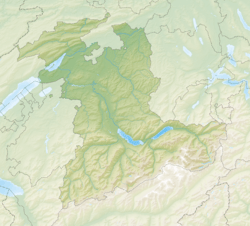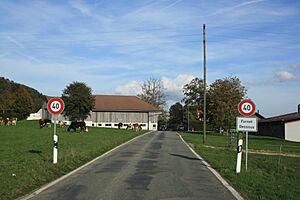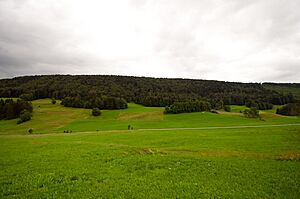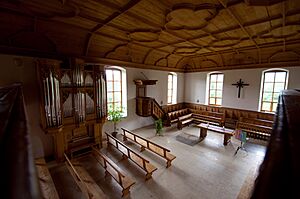Petit-Val facts for kids
Quick facts for kids
Petit-Val
|
||
|---|---|---|
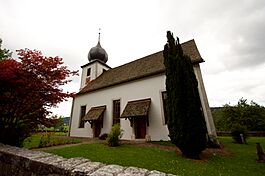
Sornetan village church
|
||
|
||
| Country | Switzerland | |
| Canton | Bern | |
| District | Jura bernois | |
| Area | ||
| • Total | 23.9 km2 (9.2 sq mi) | |
| Elevation | 843 m (2,766 ft) | |
| Population
(Dec 2020 )
|
||
| • Total | 392 | |
| • Density | 16.40/km2 (42.48/sq mi) | |
| Postal code |
2715/2716/2748
|
|
| Surrounded by | Saicourt, Saules, Undervelier | |
Petit-Val is a small town, also known as a municipality, in Switzerland. It is located in the Jura Bernois administrative district within the canton of Bern. This area is known as the French-speaking Bernese Jura.
On January 1, 2015, four smaller towns joined together to form Petit-Val. These towns were Châtelat, Monible, Sornetan, and Souboz.
Contents
History of Petit-Val's Villages
Petit-Val was formed by combining four older villages. Each of these villages has its own interesting history.
Châtelat's Past
The village of Châtelat was first written about in the year 1335. For a long time, it was connected to the church area (called a parish) of Sornetan. This area was overseen by a religious leader called a provost from the Moutier-Grandval Abbey.
In 1531, during the Protestant Reformation, both Châtelat and Sornetan changed to the new Protestant faith. Later, a group of Mennonites settled in a village called Moron. This village was high up on the Moron mountain, at about 1,020 meters (3,346 feet) high. Like many Mennonite settlements, it was in a hard-to-reach place.
In 1797, the French army won a battle and Châtelat became part of France. It was first in a French region called Mont-Terrible, then in Haut-Rhin. After Napoleon was defeated, Châtelat became part of the Canton of Bern in Switzerland in 1815.
The village of Fornet-Dessous was once separate but later joined Châtelat. In 1829, a big fire destroyed Fornet-Dessous. Today, Châtelat is still a mostly farming area. About two-thirds of the jobs there are in agriculture.
Monible's Story
Monible was first mentioned in a document from 1403, though the document itself was written in 1414. It was also mentioned as "Monible" in 1537.
For much of its history, Monible was part of the Sornetan area, overseen by the provost of Moutier-Grandval Abbey. This provost was under the Prince-Bishop of Basel. In 1743, most of Monible was destroyed by a fire.
After the French invaded Switzerland in 1798, Monible became part of France. It was in the French region of Mont-Terrible, then Haut-Rhin. After Napoleon's defeat, Monible became part of the Canton of Bern in 1815.
The number of people living in Monible has been going down since the 1800s. The village primary school closed in 1956. Today, only a kindergarten is still open there.
Sornetan's Past
Sornetan was first mentioned in 1179. The area around Sornetan has been lived in for a very long time. People have found items from ancient Celtic tribes, Romans, and Burgundians.
A noble family named Sornetan lived here from the 1100s to the 1300s. The village later became owned by the college of canons from Moutier-Grandval Abbey. When the Abbey was closed during the Protestant Reformation, Sornetan was placed under the provost of Moutier-Grandval. This provost was under the Prince-Bishop of Basel.
Like the other villages, Sornetan became part of France after the French victory in 1797. It was in Mont-Terrible, then Haut-Rhin. In 1815, after Napoleon's defeat, Sornetan joined the Canton of Bern.
Sornetan's church history also changed over time. It became an independent parish in 1746. The current parish church was built in 1708-09. It is now a very important Swiss heritage site.
While Sornetan has mostly been a farming village, other jobs have become more important since the 1970s. This is partly because a Swiss Reformed Church meeting and training center was built there in 1971.
Souboz's History
Souboz was first mentioned in 1398. For most of its history, it was owned by the college of canons from Moutier-Grandval Abbey. They were under the Prince-Bishop of Basel.
During the Protestant Reformation, Souboz also adopted the new faith. It became part of the Moutier church area. After the French victory in 1797, Souboz became part of France, first in Mont-Terrible, then in Haut-Rhin. In 1815, after Napoleon's defeat, Souboz was assigned to the Canton of Bern.
In the early 1900s, Souboz had money problems. From 1926 to 1937, the mayor of Moutier had to help manage Souboz to get it out of debt. Today, Souboz is still mostly a farming community. About 80% of the jobs there are in agriculture.
Geography
The villages that now make up Petit-Val cover a total area of about 5.62 square kilometers (2.17 square miles).
Population
As of 2011, the total population of Petit-Val was 129 people.
Important Heritage Sites
Petit-Val has some very important historical sites. The Forêts du Beucle, which was a medieval iron mine, is one of them. The Reformed church in Sornetan is also a very important Swiss heritage site.
The entire villages of Châtelat and Souboz are also recognized as important Swiss heritage sites.




